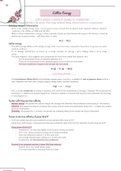Resumen
Summary CIE A level Chemistry
- Grado
- Chemistry
- Institución
- Bachillerato
These are chemistry summaries with code 9701 Alevel Chemistry for the Cambridge exam board. These are for the second year of the course and covers all of the syllabus points with images and examples. 1) Lattice energy 2) Electrochemistry 3) Equilibria 4) Reaction kinetics 5) Entropy & Gibbs fr...
[Mostrar más]



